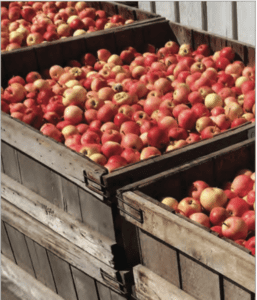By Vern Grubinger
Editor’s note: Vern Grubinger, who is based in the University of Vermont Extension office in Brattleboro, is the extension vegetable and berry specialist.
Thanksgiving is a time for families to get together…and eat! Much of the food traditionally consumed on this holiday originated in the Americas. And today, a lot of it is available from local farms, so you can support Vermont’s agriculture while eating tasty products that you know will be grown with integrity.
Turkey is widely associated with Thanksgiving. The turkey was domesticated by the Aztecs in Mexico and brought to Europe by the Spanish and English. Over 200 million turkeys are produced in the U.S. each year on 2,500 farms. In Vermont, the most recent Census of Agriculture reported 121 farms producing turkeys. Only two of those sold more than 2,000 birds, so if you want a local turkey, try to buy one early while supplies last.

Sweet potatoes are native to South America. The sweet potato has a tuberous root with skin and flesh colors that can be yellow, orange, red, brown or purple, depending on the variety. Those with dark orange flesh are high in beta-carotene, which our bodies convert to vitamin A.
Sweet potatoes also contain vitamins C and B6 along with potassium, calcium and quite a bit of fiber. The U.S. grows about 150,000 acres of sweet potatoes, the majority in North Carolina. Several dozen farms in Vermont grow sweet potatoes, and they store well, so local tubers are available this time of year.
Potatoes also originated in South America. Globally, they are the fourth most important food crop for people, after corn, rice and wheat. Potato tubers are not part of the root but rather a swollen underground stem.
Potatoes are a good source of vitamin C and potassium. One medium baked potato contains only 110 calories, — without butter or sour cream! There are blue, red, yellow, white and russet varieties.
Over 900,000 acres of potatoes are grown in the U.S., more than half of them in Idaho and Washington. About 200 farms grow potatoes in Vermont. Many store their crop into early winter, so it should be easy to buy local spuds.
Squash was an essential part of the Native American diet along with beans and corn. Butternut squash is a Thanksgiving staple, but there are other winter squashes to consider, such as acorn which has moist flesh with a nutty flavor and buttercup, which is very sweet. Delicata is milder and less sweet with a thin skin that does not need to be removed before cooking. Sunshine is stringless.
Winter squashes are similar to sweet potatoes in nutritional value though a bit lower in calories and sugar content. Winter squash is widely grown on Vermont vegetable farms and featured in colorful displays with different varieties at farm stands and retail stores across the state.
The cranberry species we commonly eat is native to the eastern United States and Canada. The U.S. leads the world in cranberry production at over 800 million pounds annually, mostly from Wisconsin and Massachusetts. Cranberries are high in vitamin C, manganese, fiber and antioxidants. Only three farms are reported to grow cranberries in Vermont, but there are plenty available from our neighboring state to the south.Hard apple cider was widely consumed before the mid-1800s, when fermented drinks helped avoid risks of drinking contaminated “tap” water. Later, unfermented, sweet cider became more common.
Introduced to North America from Europe, apple trees grow well in our climate. Over 300 farms grow apples in Vermont, and orchards press cider from their own crop. Each farm’s cider has a unique flavor.
So this Thanksgiving, have a delicious meal while celebrating family, friends—and local farms!




